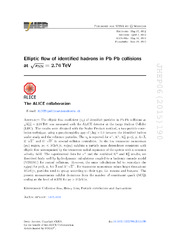Elliptic flow of identified hadrons in Pb-Pb collisions at \(\sqrt{s_{\rm{NN}}}\) = 2.76 TeV
Abelev, Betty; Adam, Jaroslav; Adamová, Dagmar; Aggarwal, Madan M.; Agnello, Michelangelo; Agostinelli, Andrea; Agrawal, Nikita; Ahammed, Zubayer; Ahmad, Nazeer; Ahmed, Ijaz; Alme, Johan; Erdal, Hege Austrheim; Helstrup, Håvard; Hetland, Kristin Fanebust; Kileng, Bjarte; Altinpinar, Sedat; Djuvsland, Øystein; Fehlker, Dominik; Haaland, Øystein Senneset; Huang, Meidana; Lønne, Per-Ivar; Nystrand, Joakim; Rehman, Attiq ur; Røhrich, Dieter; Skjerdal, Kyrre; Ullaland, Kjetil; Velure, Arild; Wagner, Boris; Yang, Shiming; Zhou, Zhuo; Arsene, Ionut Christian; Bätzing, Paul Christoph; Dordic, Olja; Lindal, Svein; Mahmood, Sohail Musa; Milosevic, Jovan; Qvigstad, Henrik; Richter, Matthias Rudolph; Røed, Ketil; Skaali, Toralf Bernhard; Tveter, Trine Spedstad; Wikne, Jon Christopher; Zhao, Chengxin; Langøy, Rune; Lien, Jørgen André; Ahn, Sang Un; Ahn, Sul-Ah; Aimo, Ilaria; Aiola, Salvatore; Ajaz, Muhammad; ALICE, Collaboration
Peer reviewed, Journal article
Published version

View/
Date
2015-06-29Metadata
Show full item recordCollections
Original version
https://doi.org/10.1007/jhep06(2015)190Abstract
The elliptic flow coefficient \(v_{2}\) of identified particles in Pb--Pb collisions at \(\sqrt{s_\mathrm{{NN}}} = 2.76\) TeV was measured with the ALICE detector at the LHC. The results were obtained with the Scalar Product method, a two-particle correlation technique, using a pseudo-rapidity gap of \(|\Delta\eta| > 0.9\) between the identified hadron under study and the reference particles. The \(v_2\) is reported for \(\pi^{\pm}\). \(\mathrm{K}^{\pm}\). \(\mathrm{K}^0_\mathrm{S}\). p+\).overline{\mathrm{p}}\). \(\mathrm{\phi}\). \(\Lambda\).\).overline{\mathrm{\Lambda}}\). \(\Xi^-\).\).overline{\Xi}^+\) and \(\Omega^-\).\).overline{\Omega}^+\) in several collision centralities. In the low transverse momentum \(p_{\mathrm{T}}\) region, \(p_{\mathrm{T}} < 2 \(GeV/\).\). \(v_2(p_\mathrm{T})\) exhibits a particle mass dependence consistent with elliptic flow accompanied by the transverse radial expansion of the system with a common velocity field. The experimental data for \(\pi^{\pm}\) and \(\mathrm{K}\) are described fairly well by hydrodynamical calculations coupled to a hadronic cascade model (VISHNU) for central collisions. However, the same calculations fail to reproduce the \(v_2(p_\mathrm{T})\) for p+\).overline{\mathrm{p}}\). \(\mathrm{\phi}\). \(\Lambda\).\).overline{\mathrm{\Lambda}}\) and \(\Xi^-\).\).overline{\Xi}^+\). For transverse momentum values larger than about 3 GeV/\).\). particles tend to group according to their type, i.e. mesons and baryons. However, the experimental data at the LHC exhibit deviations from the number of constituent quark (NCQ) scaling at the level of \(\pm\).0\).\) for \(p_{\mathrm{T}} > 3 \(GeV/\).\).
